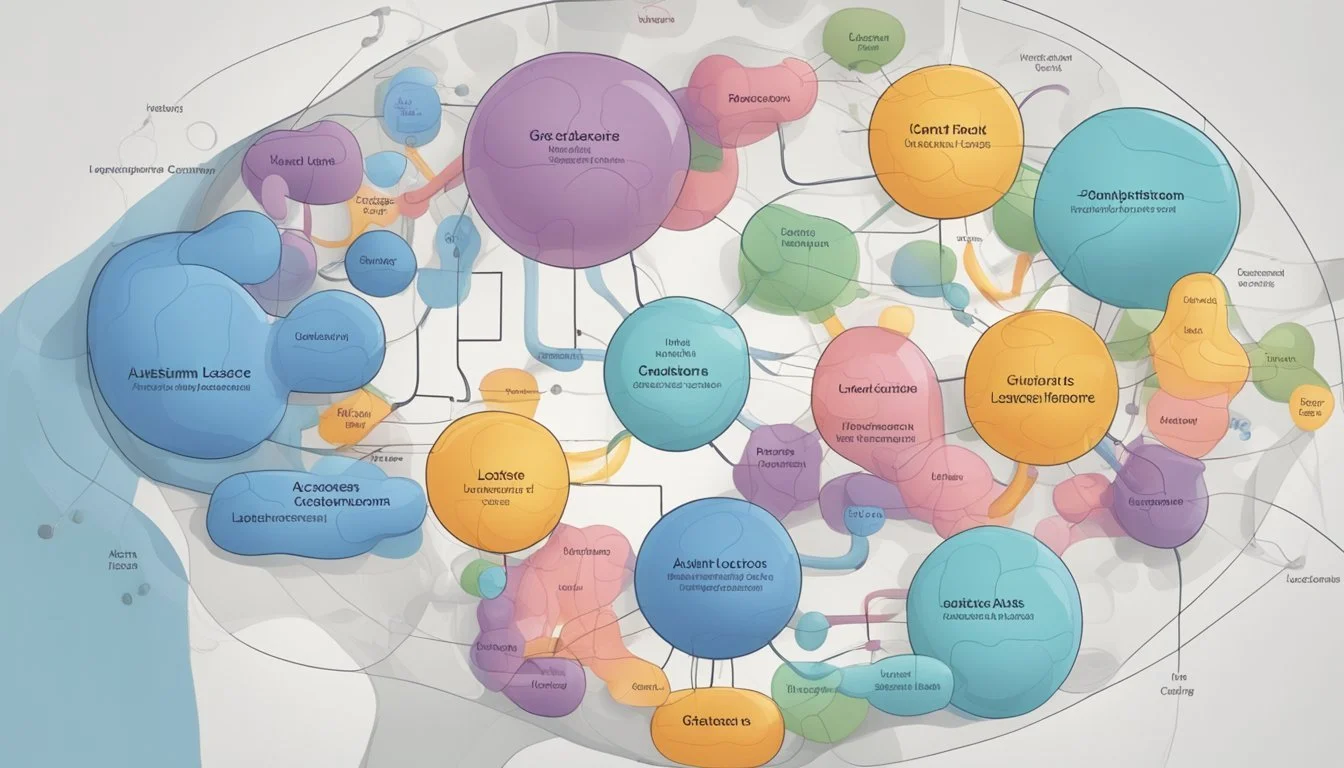Can Lactose Intolerance Cause Autism?
Exploring the Evidence
Lactose intolerance, a condition in which individuals have difficulty digesting lactose due to a deficiency of the enzyme lactase, is commonly known for causing gastrointestinal symptoms like bloating, gas, and diarrhea. However, in the search for understanding the myriad factors that might influence the development and presentation of autism spectrum disorder (ASD), the role of dietary components and digestive health has come under scrutiny. Despite the exploration of this relationship, current scientific consensus holds that lactose intolerance does not cause autism. Autism is a neurodevelopmental disorder characterized by social communication challenges and restricted, repetitive patterns of behavior, interests, or activities, with its origins believed to be multifactorial, including genetic and environmental components.
The interest in the connection between ASD and gastrointestinal symptoms has been fueled by observations that some individuals with autism experience a higher prevalence of digestive issues compared to their neurotypical peers. These digestive symptoms can sometimes be misattribated as causal factors in ASD, but they are more accurately characterized as comorbid conditions. It is important for caregivers and health professionals to recognize and manage these gastrointestinal symptoms to improve the quality of life for individuals with autism, but this management does not address the foundational aspects of the neurodevelopmental disorder itself.
Given the complexity of both ASD and gastrointestinal disorders like lactose intolerance, it is crucial to rely on evidence-based medicine when considering their relationship. The current body of research does not support the idea that lactose intolerance can cause autism, nor is there evidence to suggest that the avoidance of lactose can prevent or treat ASD. Instead, the focus remains on understanding the unique needs of each individual with autism, including addressing any comorbid conditions such as lactose intolerance to support overall well-being.
Overview of Lactose Intolerance
Lactose intolerance is an inability to digest lactose, leading to gastrointestinal symptoms after consuming dairy products. Understanding its definition, underlying mechanisms, and diagnostic criteria provides insight into its prevalence and impact on individuals.
Definition and Symptoms
Lactose intolerance occurs when the small intestine does not produce enough lactase, an enzyme required to digest lactose, the sugar found in milk and dairy products. This deficiency can lead to several symptoms, typically appearing within a few hours of consumption. Common symptoms include:
Diarrhea
Gas
Bloating
These symptoms arise because undigested lactose passes into the colon, where it is fermented by bacteria, producing gases and attracting water.
Lactose Intolerance Mechanisms
At the core of lactose intolerance is the body's insufficient production of lactase. Without adequate lactase, lactose remains undigested in the small intestine, leading to discomfort. Several factors can influence lactase production:
Genetic predisposition: Some individuals have a genetically encoded decline in lactase after childhood.
Intestinal injury or illness: Damage to the small intestine, such as from an infection or surgery, can reduce lactase production.
Developmental factors: Lactase levels typically decrease naturally with age, especially in individuals of non-European descent.
Diagnosis and Prevalence
Diagnosing lactose intolerance involves a combination of patient history, symptom observation, and diagnostic tests such as the hydrogen breath test or lactose tolerance test. The prevalence of lactose intolerance can vary widely:
Ethnic background plays a significant role, with higher rates in Asian, African, and Indigenous populations.
It is less common among people of Northern European descent.
Understanding the condition is essential, as lactose intolerance affects a large portion of the global population, impacting dietary choices and quality of life.
Understanding Autism Spectrum Disorder
Autism Spectrum Disorder (ASD) is a complex neurodevelopmental condition with varying degrees of severity. It impacts cognition and behavior, often presenting challenges in communication and social interactions.
Characteristics of Autism
Autism, commonly referred to within the broader category of Autism Spectrum Disorder (ASD), is characterized by a range of symptoms that manifests uniquely in each individual. These characteristics are:
Persistent Deficits: Difficulty with social communication and interaction.
Repetitive Behaviors: Engaging in repetitive behaviors, patterns of behavior, or activities.
Special Interests: Intense, highly focused interests on specific subjects or activities.
Sensory Sensitivities: Over or under-reactivity to sensory input, such as sounds, textures, or lights.
Children with ASD might display a mix of these symptoms, each to a different extent. For instance, a child might have strong verbal skills but still struggle with non-verbal communication. Alternatively, another child might have considerably less developed speech but might not show as much repetitive behavior.
Autism Spectrum Disorder Diagnosis
To diagnose Autism Spectrum Disorder, several criteria set by standardized diagnostic tools and assessments must be met:
Developmental History: Collecting detailed information on milestones and behaviors from early childhood.
Behavioral Observation: Assessing the child's behavior and interactions.
Other Assessments: Checking for associated features not specific to autism but often present, such as sensory sensitivities.
Notably, disorders such as Asperger Syndrome are now included under the broader ASD diagnosis. Clinicians consider the severity and combination of symptoms, and some may use a level system indicating support needs.
In summary, ASD encompasses an array of symptoms impacting social skills, repetitive behaviors, and communication. Early and accurate diagnosis is critical for managing ASD and providing the appropriate support and interventions.
The Autism-Gut Connection
Emerging research indicates a complex relationship between autism spectrum disorders (ASD) and gastrointestinal (GI) issues, influenced by the gut-brain axis and the gut microbiome.
Gastrointestinal Issues in ASD
Individuals with ASD frequently experience GI symptoms which range in severity. Common GI problems include constipation, diarrhea, and abdominal pain. The prevalence of these conditions often correlates with the severity of ASD symptoms. Additionally, children with ASD may exhibit selective eating behaviors which can exacerbate GI issues.
Severity: The presence and severity of GI symptoms can reflect the level of autism-related behavioral disturbances.
Feeding Problems: Restricted diets due to selective eating are common, potentially leading to unbalanced gut microbiota.
The Gut-Brain Axis
This axis represents a bidirectional communication network that links the enteric nervous system of the gut with the central nervous system. Disruptions in this communication may influence neurodevelopment and behavior in individuals with ASD.
Aberrations in this axis could explain the co-occurrence of GI symptoms with autism-related behaviors.
The concept of leaky gut syndrome, where harmful substances are thought to pass through the intestinal lining, remains a controversial topic but is sometimes discussed in relation to ASD.
Microbiome and Probiotics
The gut microbiome plays a crucial role in human health, with imbalances perhaps impacting individuals with ASD. Studies suggest that probiotics may be beneficial in managing GI symptoms for some.
Gut Microbiome: An imbalanced gut microbiome may contribute to the development of GI symptoms in ASD.
Probiotics: Evidence indicates that probiotics can aid in restoring a healthy gut microbiome which may alleviate some GI symptoms.
Diet and Nutrition in ASD
Diet and nutrition play a pivotal role in the health and well-being of individuals with autism spectrum disorder (ASD), involving unique dietary challenges and the potential influence of diet on ASD symptoms. Carefully considered nutritional interventions can assist in managing these aspects.
Dietary Challenges and Strategies
Individuals with ASD may face several dietary challenges. Food selectivity is a common issue among people with ASD, frequently leading to a limited diet. This selectivity often stems from sensory sensitivities to certain textures, smells, or tastes of foods. As a result, some individuals might exclude whole food groups, potentially leading to nutrient deficiencies.
To address these challenges, strategies may be implemented, often with the guidance of a dietitian. These can include:
Introducing new foods slowly and in a non-stressful environment.
Encouraging a variety of foods to ensure a balanced intake of essential nutrients.
Incorporating preferred textures and flavors to make new foods more acceptable.
Impact of Diet on ASD Symptoms
The impact of diet on ASD symptoms is an area of continuing research. Some studies have indicated that certain foods or food components may influence ASD symptoms, but these effects can be highly individual. For instance, some parents report improvements in behavior when their children with ASD follow a gluten-free or dairy-free diet. These diets eliminate gluten, a protein found in wheat and other grains, and casein, a protein found in dairy products.
However, it's important to note that the scientific consensus on the efficacy of these diets in managing ASD symptoms is not definitive, and such dietary changes should be made cautiously to avoid nutritional imbalances.
Nutrition and Dietary Interventions
Nutritional and dietary interventions are often considered for individuals with ASD to ensure adequate nutrition and to address specific dietary problems. This is crucial as some individuals with ASD may have allergies or intolerances, such as lactose intolerance, which necessitates a dairy-free diet. The role of a dietitian is to ensure that, even with restrictions, an individual's diet contains all the necessary nutrients. For instance, a calcium intake must be monitored and managed, particularly when dairy is eliminated, as it is a primary source of this nutrient.
Dietary interventions can include tailored plans that incorporate necessary vitamins and minerals, and sometimes supplements, to address specific dietary needs. These interventions are developed with a careful consideration of the person's preferences, ensuring a holistic approach to health and well-being in ASD.
Exploring Potential Links
The interplay between nutrition and genetic influences in autism spectrum disorder (ASD) reflects the complexity of its pathogenesis. Misconceptions about diet-related causes of ASD necessitate clarification.
The Role of Diet in ASD Development
Research suggests that diet can influence the health and behavior of individuals with ASD. While diet is not a primary cause of autism, it may exacerbate or ameliorate symptoms in some cases. Genetic predispositions can affect how the body processes foods and nutrients, which could interact with the pathogenesis of ASD.
Genes: Certain gene mutations are implicated in ASD and may be sensitive to dietary components.
Environment: Exposures to certain environmental factors may interact with genetic risks to influence ASD development.
Food Allergens: Some individuals with ASD may have food sensitivities or allergies that affect their behavior and gastrointestinal health.
Interventions such as a dairy-free diet are sometimes considered for those with ASD, not as a cure, but aiming to improve quality of life if food sensitivities are present.
Debunking Myths: Lactose Intolerance and Autism
Contrary to some myths, lactose intolerance is not a cause of autism. However, secondary conditions such as lactose intolerance can occur alongside ASD.
Dairy-Free: Adopting a dairy-free diet can help manage symptoms of lactose intolerance, but it is not a treatment for ASD itself.
Secondary Conditions: While digestive issues are common in individuals with ASD, they are considered secondary to the diagnosis.
It is important for healthcare providers to assess individual cases for food allergens and intolerances to provide tailored dietary recommendations.
Management and Support Strategies
Effective management of lactose intolerance in individuals with autism involves a combination of medical guidance and community support. These strategies aim to alleviate symptoms and improve the quality of life for individuals and their families.
Medical and Behavioral Interventions
Dietary Adjustments:
Tailoring the diet is critical. A registered dietitian can help identify lactose-containing foods and suggest suitable alternatives that maintain nutritional balance. Lactose-free options and lactase supplements can aid digestion and reduce gastrointestinal discomfort.
Inclusion of Probiotics:
Probiotics contribute to gut health and may alleviate the symptoms of lactose intolerance. They should be considered as part of a comprehensive dietary plan.
Behavioral Support:
Managing behavioral problems linked to discomfort from lactose intolerance necessitates a nuanced approach. Behavioral therapies, when integrated with dietary management, can help mitigate stress and anxiety associated with dietary restrictions.
Support for Individuals and Families
Guidance from ASD Community:
Support groups within the ASD community offer valuable resources and shared experiences to help families navigate lactose intolerance and autism.
Collaboration with Professionals:
Continuous collaboration with healthcare providers ensures the monitoring of an individual's progress and the adjustment of support strategies.
Educational Resources:
Education for the individual and family about lactose intolerance and its management plays a vital role. Access to clear, actionable information can empower those affected to make informed decisions about their health care.
Lactose Intolerance and Related Conditions
Lactose intolerance can have intriguing associations with various health conditions, illustrating a complex interplay between digestion and systemic health.
Lactose Intolerance vs Food Allergies
Lactose intolerance and food allergies are distinct conditions, each with a specific physiological impact. Lactose intolerance involves the body's inability to digest lactose due to a deficiency in lactase, an enzyme produced in the small intestine. Symptoms may include diarrhea, gas, and bloating after consuming dairy products.
In contrast, a food allergy is an immune system reaction that occurs soon after eating a certain food, even in small amounts. Common symptoms can range from hives to anaphylaxis, a potentially life-threatening condition. Wheat allergy is one example of a food allergy that should not be confused with the immune-related disorder celiac disease, which leads to damage in the small intestine when gluten is consumed.
Co-Occurring Conditions with Lactose Intolerance
Individuals with lactose intolerance often navigate co-occurring digestive health issues. For instance, those with lactose intolerance may also experience constipation, differing from the more common symptom of diarrhea as the body may react variably to lactose consumption. While not causative, there is an observed overlap in symptoms between lactose intolerance and autism spectrum disorder (ASD). Studies are ongoing to better understand the potential benefits of a gluten-free or dairy-free diet in individuals with ASD.









